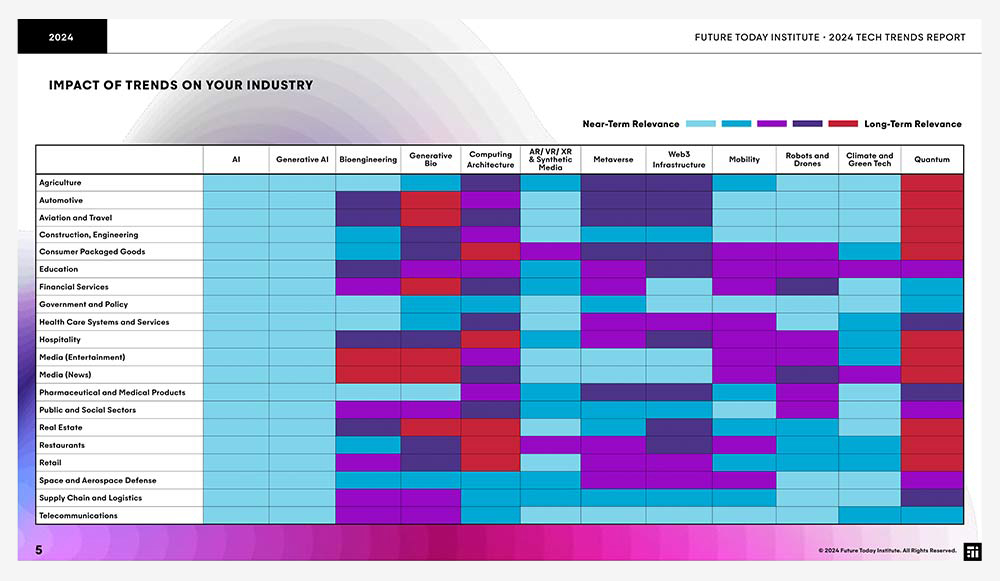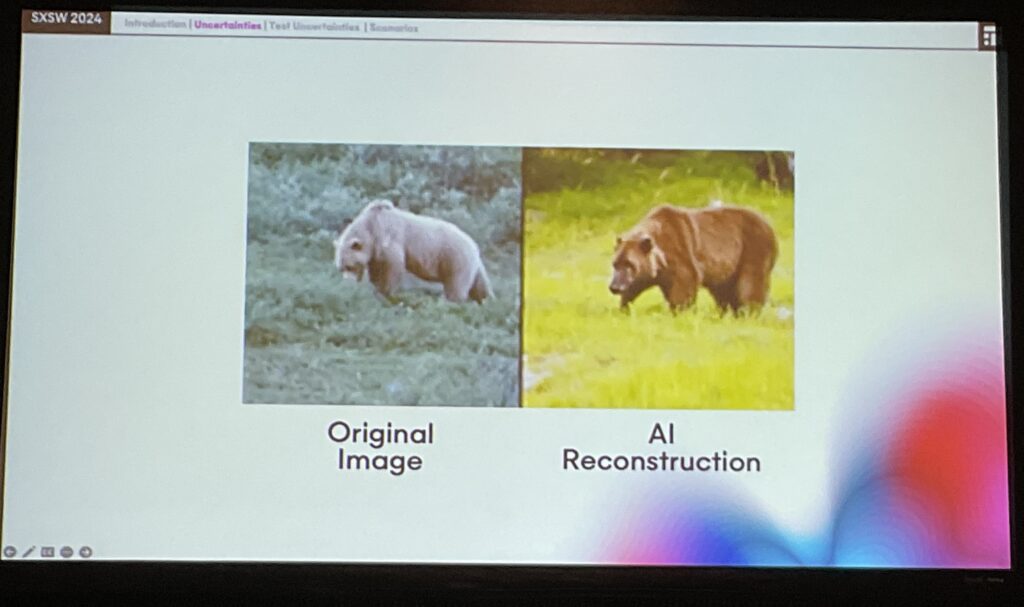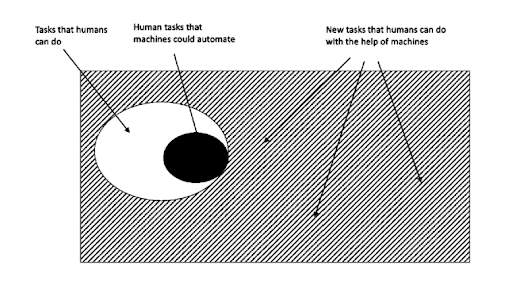

AI & Trusted Interactions
3 things you need to know
Over the last few years, Else has been working in digital trust, identity, and AI spaces with large global enterprises and innovative start-ups. We’ve been thinking about the impact of AI and how to design experiences around it in our R&D efforts since 2018 – and while we wouldn’t claim to be out-and-out ‘AI Experts’ necessarily, we’re definitely not ‘Johnny-come-lately’s virtue signalling on LinkedIn with our new ‘Head of AI Innovation’.
In the last year, AI has gone from hype to mainstream, with 83% of companies claiming AI is a top priority in their business plans and MIT reporting that 9 in 10 companies back AI to give them a competitive edge over rivals.
The disruption isn’t a one-off; it’s in waves, and if you’re still paddling in the shallows, it won’t be long before it washes you away. The urgency for businesses to integrate AI into their strategic planning has never been more apparent.
As Amy Webb explained at SXSW this year, we’re in a technology supercycle. In this supercycle, there is a confluence of general-purpose technologies (AI, Biotech, IoT) that are fuelling each other and will permeate multiple aspects of our economy and society. A Supercycle is where a new technology permeates multiple aspects of our economy and society. Think electricity and the steam engine that kicked off the Industrial Revolution.
This supercycle is driving AI into everything; into every industry. And AI will disrupt everything.

Above: Future Today Institute – Impact of Trends on Industry Report
But we’re in this together, and as Shane Legg, co-Founder of Deepmind put it:
‘We’re in a profoundly transformative time and we need a certain amount of humility to understand what happens next’.
This briefing highlights our top three takeaways on AI’s impact, opportunity and implications. It provides an Else perspective on navigating this continually evolving landscape.
1. AI is in everything - the imperative for an AI strategy
Firstly, AI’s influence across industries demands businesses develop a robust AI strategy, but this is easier said than done.
Albeit anecdotally, we’re hearing of senior leaders demanding ‘more AI’ from their teams, but the teams are wondering, “This is new… where do we start? On what? With what?”. With respect to AI, some companies are kind of doing the Spiderman thing.

AI technologies are rapidly and extensively redefining how companies operate and compete, and they are disrupting the way we work and the product and service experiences we provide. They are affecting both the marketing front-end and the product development loop, and many are underestimating the need and speed, to not just adopt AI, but integrate it strategically.
As we say at Else, disrupt or risk being disrupted.
Gartner predicts that by 2028, search traffic will decline by more than half. While Gartner says this is driven by the adoption of AI and GPTs—where you can ‘ask’ and not ‘search’—we also think this is partly due to people being fed up with misinformation and disinformation. This goes further to say that 70% of consumers express at least some trust in GenAI-backed search results, with 20% showing complete trust.
This shift will require brands to adapt their channel investments as ‘search’ drops off.
Social media interaction is also expected to plummet (Gartner says it’ll drop 50% by 2025), again driven by misinformation, toxic user bases, fake accounts, and bots that degrade the idea of a ‘social user experience’. More than 70% of consumers anticipate GenAI will further harm social media.
So, what does this mean as brands diversify media spend beyond social?
GPTs and personal AIs are set to create massive disruption in the marketing funnel that businesses have spent the best part of 20 years optimising. The customer experience (CX) will evolve, possibly collapse, with personal AIs handling tasks autonomously based on user preferences, such as checking into flights, managing taxis, and claiming refunds. This shift implies the traditional user journey will fade and be replaced by seamless interactions between personal AIs. Cue the rise in a need for trust.
So, to avoid disruption, we suggest starting the work to mitigate this emergent shift now.
2. AI creates more opportunities than it takes away
The narrative that AI displaces jobs overlooks the broader perspective—as there is far more opportunity in augmenting humans to do new tasks rather than automating what we already do. A lot of AI talk is focused on GenAI and how it can free us up around the tasks we do each day, but GenAI is just one kind of AI. Gen AI, of course, is just at one end of the spectrum; at the other end, we have AI augmentation of humans – and even that is nearer than you think. The main point, however, is that the advent of the AI era creates a wide range of new opportunities for those of us working at the intersection between people, technology and brands.
At the sci-fi end of things, Ray Kurzweil, the longest-living person to be involved in AI development, was asked on stage at SXSW, “How long it would be before we can download the entire contents of your brain and express it through a machine?” In response, Kurzweil talked about the idea of human longevity reaching escape velocity where advances in science, technology and medicine outstrip that of our natural longevity. For every year we use in our lives, science can help us claw back 4 months. As technology advances (and with AI accelerating biotech), it won’t be long before science gives us back more than a year of the longevity we use. Kurzweil continues, “…if you’re diligent, you’ll achieve it by 2029”. Science fiction to reality in less than 5 years. Mind bent? Well, pop over here to watch the entire interview.
But let’s return to the AI, BioTech, IoT Supercycle, and the current ‘mainstream’ AI that is seemingly running out of data.
It’s estimated that AI will run out of data to consume in approximately two years—that is, the readable internet of all the things we’ve created, written, photographed, filmed, etc. And so begins the arms race for more data, specifically sensory data or ‘intent’ data.
The emergence of devices like Apple’s VisionPro highlights a convergence of AI, spatial computing/augmented reality, with the device gathering intent data using its 14 cameras and LiDAR scanner. These cameras monitor your eye movements, and given that your pupil dilates before your brain registers the thought, it’s not a leap to say that AI will know what you feel before you do.
Segue. While we’re on this one (AI reading your mind), how about this image taken from a presentation by Future Today Institute at SXSW, showing how AI reconstructed an image after analysing brain waves using an FMRI scanner. Subjects were shown the image on the left, AI recreated the one on the right.

Like? Thought not.
Back on track. Ultimately, this signals a move towards gathering intent data, which AI will use to anticipate our needs. As such, we’ll see an explosion of these devices, such as the recently launched Rabbit r1 and the much-maligned Humane Pin. These devices are in their early stages, but they’re signalling a big change in the nature of our experiences and a shift away from the classic user interface.
To summarise this opportunity, the best illustration is the following diagram from MIT article The Turing Trap. This is the ‘Why this? Why now?’ opportunity space of human and AI convergence. Naturally, for us here at Else, this is exciting news because it illustrates a whole new playground for products and services to be created within.
It emphasises that the real value of AI lies in its ability to complement human strengths. For example, while an AI might be able to perform data analysis at incredible speeds, it is the human ability to interpret these analyses and apply them creatively that drives true innovation. This symbiotic relationship between human and machine can lead to breakthroughs that neither could achieve alone. Let’s go.
3. AI will drag Web3 with it - the need for a trusted interactions strategy
Now, let’s move on to some of the challenges presented by AI’s rapid emergence, particularly those related to data privacy, trust, and bias.
Starting with bias, Dr Joy Buolamwini gave a brilliant presentation at SXSW, where she shared her work at MIT and in establishing The Algorithmic Justice League – to question and expose the bias inherent in AI systems based upon how they are trained. She so eloquently and enthusiastically shows the extent of the problem we’re facing as a society, some more so than others.
In the trailer to her Netflix film, Coded Bias one terrifying quote is that “…racism is being codified”. Her talk and documentary expose the extent to which this can affect ALL our daily lives, coupled with the Clearview AI case from 2022, the growing body of evidence to be concerned about privacy and trust is gathering.

As she wrapped up her onslaught against automated injustice, she rightly pointed out that
“We have a voice, and we have a choice, and we don’t have to accept digital de-humanisation.”
Digital de-humanisation. Hmmmm.
For our money, she was one of the best talks at SXSW this year, and you can watch the whole thing here.
Well, one route for stymying the mayhem is regulation. Yet, understanding and complying with evolving AI regulations is crucial to avoid legal pitfalls and understand what is happening. However, as with many aspects of the internet, technological advancement outstrips the development of law.
However, formally adopted on 21st May 2024, the EU Artificial Intelligence Act aims to ensure AI systems are safe and respect fundamental rights, setting a precedent for global AI governance. This is in contrast to the UK, which, so far, has decided to hold off on regulation so as not to stifle innovation.
We’ll continue to monitor this situation because the Ethics in AI debate is building up quite a head of steam – rightly so.
AI innovation is one thing; AI innovation in the
context of ethics is another; and bringing consumers and businesses along for the ride is quite another, and it is evident to us (having worked on ‘trust’ projects for the last 18 months to 2 years) that the fast rise of AI is going to drag trust (enabled by web3 technologies) with it.
Fostering trust with users is going to become a business-critical issue, especially as AI systems become more integrated into daily life and we see increasing automation, more personal AI, and a significant increase in autonomous agents.
In September 2023, Ipsos reported that 94% of people were misled or influenced by disinformation at least once before finding out it was false via the media or on social media.
Navigating information is a growing challenge in the post-truth age. This survey, which spanned 16 countries all facing national elections in 2024, also revealed that 85% of people worry about the impact of disinformation on their fellow citizens. And an even greater percentage (87%) believe it has already harmed their country’s politics.
Smell that? Change is most definitely in the air. Do you want to do the disrupting? Or
As Jamie Smith– Customer Futures and ‘Friend of Else’ says:
“Humans aren’t very good at understanding non-linear progress… our digital lives are about to fundamentally shift. When we won’t be able to trust anything we see or hear. We’re going to need new digital trust infrastructure. And that can’t just be left to just the BigTech players…
We’re going to need a new breed of digital tools. Digital Wallets.Personal Vaults. Personal AI.”
Brace yourself.
Why? Well, we’re entering a phase where we aren’t going to know if the things we see/read are real. Whether they are human-generated or AI generated (the nuances in here are quite something as well). Going further, we’re not going to be sure of legitimate connections with businesses as bad actors exploit AI capability to spin up sophisticated social engineering scams. Today, we mostly deal with rogue emails, with funny addresses and poorly written language; soon, a suite of websites, emails, social content, videos, chatbots etc etc can all be ‘spun up’ to come after you. The only defence is a trusted or verified interaction.
In a world of autonomous agents and personal AI, we will not know much about how decisions are being made on our behalf.
So, all those people who have switched off when they hear the words ‘Wallet prop’ or ‘Web 3’ or ‘decentralised…’ (are you still here?) are going to have to pay attention at some point.
That said, according to Zendesk, 59% of consumers believe that generative AI will completely change the way they interact with companies in the next two years, with this figure rising to 75% among those with direct AI experience. Ensuring data privacy and security protects both the business and its customers will be imperative. Implementing ethical AI practices will help mitigate biases and enhance the overall user experience pertaining to trust.
As AI propels the adoption of Web3 technologies, businesses must develop what we describe as a ‘Trusted Interactions Strategy’, which focuses on ensuring transparency, privacy, control and ethical use of AI and data across the customer experience.
Work to do. So, if you are interested, reach out, and we’ll talk to you about Else’s Trusted Interactions Framework.
Embracing a culture of innovation
So, to summarise all this, at Else, we believe:
- AI will impact things faster than you think
- AI creates more opportunities than it takes away
- AI will drag Web3 (namely trust), with it.
So, developing an AI strategy and a Trusted Interactions strategy while exploring new products and services are not just options but imperatives for staying relevant and competitive.
Else guides businesses through this transformation, helping them harness AI’s power while navigating the complexities it brings.
How can we help?
At Else, we understand that integrating AI into your business is not a one-size-fits-all approach. By evaluating AI’s role through the lenses of enhancement, advancement, and pioneering, we help organisations harness AI’s full potential. Whether you aim to elevate operational efficiency, drive innovation, or lead transformative changes, Else provides the expertise and strategic foresight needed to navigate AI as an evolution or a revolution with success.
Else briefing
Don’t miss strategic thinking for change agents
One more step
Thanks for signing up to Else insight
We’ll only email you when we release an update.
Please check your email for a confirmation link to complete the sign up.
You’re all set
Ah! You’re already a friend of Else
You won’t miss any of our updates.
In the meantime, please enjoy Our Insights
Shared perspectives
Don’t miss strategic thinking for change agents
Find ideas at your fingertips with Else insight.
Here to help
